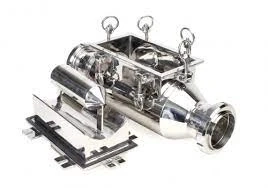Spout magnets are specialized magnetic separators used in industrial settings to remove ferrous contaminants from free-flowing materials that pass through spouts, chutes, or pipelines. They are commonly used in industries such as food processing, pharmaceuticals, plastics, chemicals, and more, where the presence of metal contaminants can pose a risk to product quality, process efficiency, and equipment integrity. In this blog, we will explore what spout magnets are, how they work, and their various applications in different industries.
Introduction to Spout Magnets
A spout magnet, also known as a chute magnet or a pipeline magnet, is a magnetic separator that is specifically designed to capture and remove ferrous contaminants from materials that are transported through spouts, chutes, or pipelines. These contaminants can include ferrous particles such as iron, steel, and stainless steel, which may be present in raw materials, powders, granules, pellets, or other free-flowing materials used in industrial processes.
Spout magnets typically consist of a stainless steel housing with one or more magnetic tubes or cartridges installed inside. These magnetic tubes or cartridges contain high-strength permanent magnets, usually made of rare-earth materials such as neodymium or samarium cobalt, which generate a strong magnetic field. When the material flows through the spout magnet, the ferrous contaminants are attracted to the magnetic tubes or cartridges and are captured on their surface, while the clean material continues to flow through the spout or chute.
How Spout Magnets Work
Spout magnets operate based on the principle of magnetic attraction. The magnetic tubes or cartridges inside the spout magnet create a strong magnetic field that attracts and captures ferrous contaminants from the flowing material. The strength of the magnetic field depends on the type and configuration of the magnets used in the spout magnet, as well as the flow rate and properties of the material being processed.
When the material flows through the spout magnet, the ferrous contaminants are drawn towards the magnetic tubes or cartridges due to the magnetic force. The contaminants adhere to the surface of the magnets, while the clean material continues to flow through the spout or chute and is collected in downstream equipment or containers. The captured contaminants can be removed from the spout magnet periodically or as needed, depending on the application and the level of contamination.
Spout magnets can be installed in various orientations, such as vertical, horizontal, or angled, depending on the requirements of the application and the space available. They can be easily integrated into existing processing lines or installed in new systems, and their design and configuration can be customized to suit specific applications and processing conditions.
Applications of Spout Magnets
Spout magnets find applications in a wide range of industries where the presence of ferrous contaminants in free-flowing materials can negatively impact product quality, process efficiency, and equipment integrity. Some of the common applications of spout magnets include:
Food Processing: Spout magnets are extensively used in food processing industries to remove metal contaminants from raw materials, ingredients, and finished products. They can effectively capture ferrous contaminants such as metal fragments, rust, or wires that may accidentally enter the processing line during handling, grinding, cutting, or packaging of food products.Pharmaceuticals: Spout magnets are utilized in pharmaceutical manufacturing processes to ensure product purity and compliance with regulatory requirements. They can remove ferrous contaminants from powders, granules, tablets, and other pharmaceutical materials, preventing contamination and protecting sensitive equipment, such as tablet presses or capsule filling machines, from damage.Plastics: Spout magnets are employed in plastic processing operations to remove metal contaminants from plastic resins, pellets, or regrind materials. They can capture ferrous contaminants such as metal screws, nails, or fines that may be present in plastic materials due to handling, transportation, or processing.Chemicals: Spout magnets are used in chemical processing plants to remove metal contaminants from powders, granules, or liquids. They can capture ferrous contaminants that may be present in raw materials, intermediates, or final products, ensuring product quality and preventing damage to downstream processing equipment.Recycling: Spout magnets are utilized in recycling facilities to remove metal contaminants from various recyclable materials, such as plastic, glass, paper, or metal. They can effectively capture ferrous contaminants that may be present in these materials due to contamination from other sources or during the recycling process.Grain and Milling: Spout magnets are commonly used in grain and milling industries to remove metal contaminants from grains, seeds, or flour. They can capture ferrous contaminants such as metal particles, nails, or wires that may accidentally enter the processing line during handling, storage, or transportation of grains.Cement and Mining: Spout magnets are employed in cement and mining industries to remove metal contaminants from raw materials, additives, or finished products. They can capture ferrous contaminants such as metal fragments, bolts, or nuts that may be present in the materials used in cement production or mining operations.Animal Feed: Spout magnets are used in animal feed processing to remove metal contaminants from feed ingredients, such as grains, meals, or pellets. They can capture ferrous contaminants that may be present in these ingredients due to handling, storage, or transportation, ensuring the quality and safety of the animal feed.Wood and Biomass: Spout magnets are commonly used in wood processing and biomass industries to remove metal contaminants from wood chips, pellets, or biomass materials. They can capture ferrous contaminants that may be present in these materials due to handling, transportation, or processing, preventing damage to downstream equipment and ensuring product quality.Recycling: Spout magnets are utilized in recycling facilities to remove metal contaminants from various recyclable materials, such as plastic, glass, paper, or metal. They can effectively capture ferrous contaminants that may be present in these materials due to contamination from other sources or during the recycling process.Benefits of Spout Magnets
Spout magnets offer several benefits in industrial settings, including:
Improved Product Quality: Spout magnets help to ensure the purity and quality of processed materials by effectively removing ferrous contaminants. This helps to prevent product contamination and ensures compliance with regulatory requirements, leading to improved product quality and customer satisfaction.Increased Process Efficiency: Spout magnets prevent metal contaminants from entering downstream processing equipment, such as mills, mixers, or extruders, which can reduce downtime, maintenance costs, and production losses due to equipment damage or jamming. This leads to increased process efficiency and productivity.Equipment Protection: Spout magnets help to protect sensitive processing equipment from damage caused by metal contaminants. By capturing ferrous contaminants before they enter the equipment, spout magnets extend the lifespan of processing equipment and reduce the need for frequent repairs or replacements.Cost Savings: Spout magnets can lead to cost savings by reducing product losses, minimizing downtime, and preventing equipment damage. Additionally, they can help to avoid costly product recalls, fines, or penalties associated with product contamination, ensuring compliance with regulatory requirements.Easy Integration: Spout magnets can be easily integrated into existing processing lines or installed in new systems with minimal modifications. They are available in various sizes, configurations, and orientations to suit different applications and processing conditions.Customization: Spout magnets can be customized to suit specific application requirements, such as the type of material being processed, the flow rate, the level of contamination, and the space available for installation. This ensures optimal performance and effectiveness in capturing ferrous contaminants.Low Maintenance: Spout magnets require minimal maintenance, making them a cost-effective solution for metal contamination removal. They typically have a self-cleaning design, where the captured ferrous contaminants are released from the magnetic tubes or grids when the spout magnet is removed from the processing line, making it easy to clean and maintain.How Does a Spout Magnet Work?
Spout magnets work based on the principles of magnetism. They use powerful magnets, typically made of rare-earth materials, such as neodymium or samarium cobalt, to attract and capture ferrous contaminants from flowing materials. The basic components of a spout magnet include a housing, magnetic tubes or grids, and a magnetic circuit.
Housing: The housing of a spout magnet is usually made of stainless steel, which provides durability and corrosion resistance. The housing is designed to be installed in the spout or chute of a processing line, allowing the material to flow through it while the magnetic tubes or grids capture the ferrous contaminants.Magnetic Tubes or Grids: The heart of a spout magnet is the magnetic tubes or grids. These are made of powerful magnets, typically arranged in a matrix pattern, and are designed to attract and capture ferrous contaminants from the flowing material. The number and spacing of the magnetic tubes or grids can be customized to suit the specific application requirements.Magnetic Circuit: The magnetic circuit of a spout magnet is designed to ensure maximum magnetic field strength and effectiveness in capturing ferrous contaminants. It typically consists of a magnetic circuit assembly, which includes the magnetic tubes or grids, and a magnetic circuit holder, which holds the magnetic tubes or grids in place. The magnetic circuit assembly is designed to optimize the magnetic field strength at the surface of the magnetic tubes or grids, ensuring efficient capture of ferrous contaminants.When the material flows through the spout magnet, the ferrous contaminants are attracted to the magnetic tubes or grids and captured on their surface. The captured contaminants remain on the surface of the magnetic tubes or grids until the spout magnet is removed from the processing line for cleaning. The captured contaminants can be easily removed by pulling out the magnetic tubes or grids from the magnetic circuit holder and wiping or brushing them off.
Installation of Spout Magnet
The installation of a spout magnet may vary depending on the specific application and processing line, but generally involves the following steps:
Identify the appropriate location: The spout magnet should be installed at a strategic location in the processing line where the material flow is optimal for effective capture of ferrous contaminants. This may require careful consideration of factors such as the flow rate, material characteristics, and the presence of other equipment or obstructions in the processing line.Prepare the spout or chute: The spout or chute where the spout magnet will be installed should be cleaned and prepared to ensure smooth and unobstructed flow of material through the spout magnet. Any residual material or debris should be removed to prevent interference with the capture of ferrous contaminants.Install the spout magnet: The spout magnet can be inserted into the spout or chute and secured in place using brackets or mounting hardware. Care should be taken to ensure proper alignment and orientation of the magnetic tubes or grids to optimize their effectiveness in capturing ferrous contaminants.Connect the spout magnet to the processing line: The spout magnet should be connected to the processing line, allowing the material to flow through it. This may involve connecting pipes, hoses, or conveyors to the spout magnet, depending on the specific setup of the processing line.Test and adjust: Once the spout magnet is installed, it should be tested to ensure its effectiveness in capturing ferrous contaminants. If necessary, adjustments can be made to the position or orientation of the spout magnet to optimize its performance.6 . Regular maintenance: Spout magnets are designed to be low-maintenance, but regular inspections and cleaning are still necessary to ensure optimal performance. Depending on the application, the frequency of cleaning may vary. When the spout magnet is removed from the processing line for cleaning, the captured ferrous contaminants can be easily wiped or brushed off the surface of the magnetic tubes or grids. It is important to follow proper safety procedures and guidelines when handling and cleaning spout magnets to avoid any injuries or accidents.
PERMAG is a leading supplier of liquid magnet trap, and we are committed to providing our customers with the highest quality products available on the market. Thanks to our state-of-the-art manufacturing process, we are able to produce magnetic rods that meet the most stringent quality standard.


